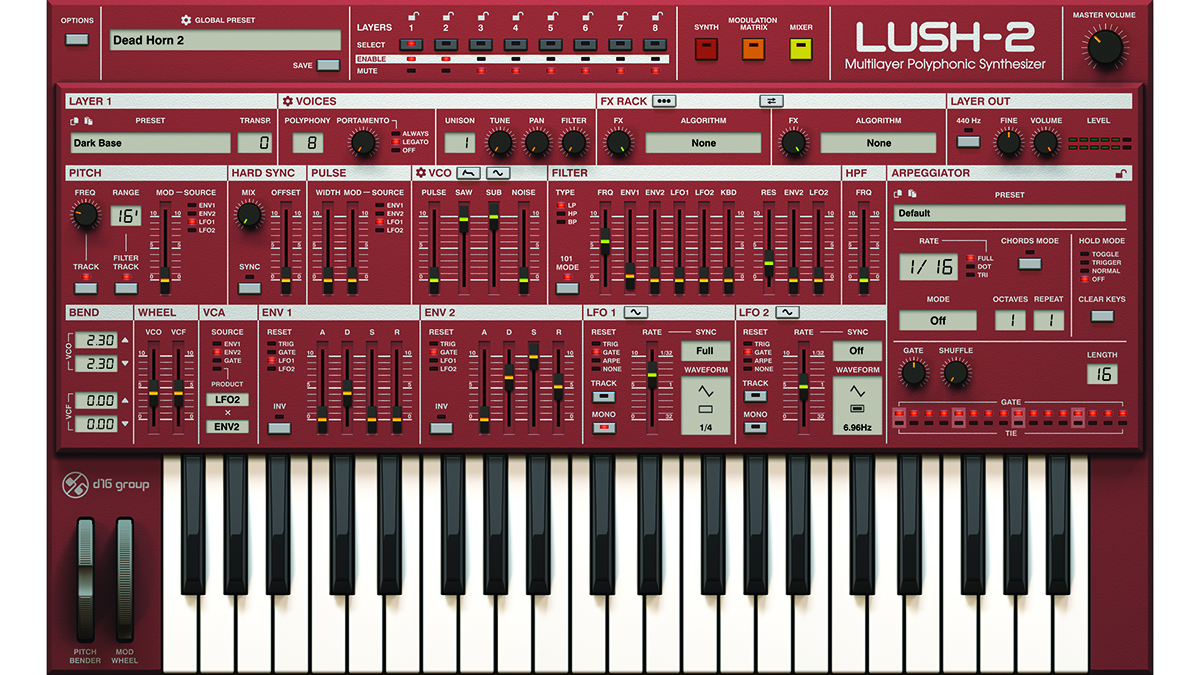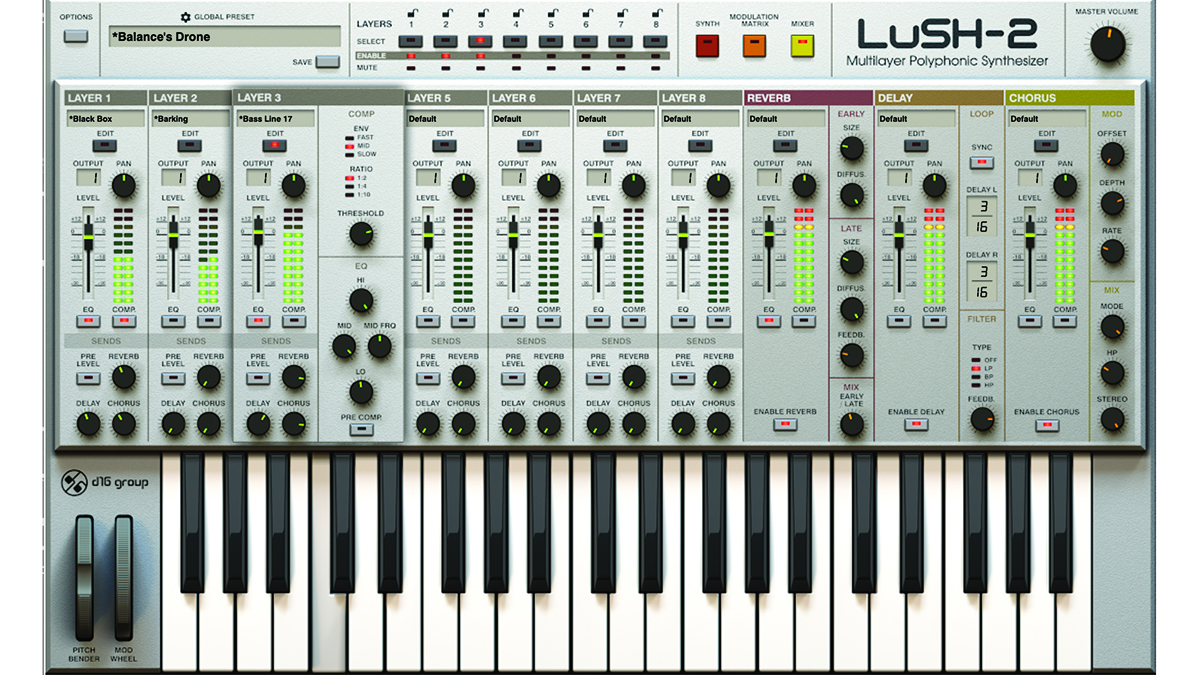MusicRadar Verdict
While most of the update is in the fine print, this is still a massive-sounding synth over a decade on and as relevant as ever. Huge, creative and whatever you want it to be.
Pros
- +
Loads of amazing sounds.
- +
Love the multitimbral setups.
- +
Easy to use and understand.
- +
Sounds massive!
Cons
- -
If you own the original LuSH 101 you’ll have much of what is here.
MusicRadar's got your back
D16 Lush 2: What is it?
- Mac OS X 10.13 to macOS 13. Intel x86 / Apple SiliconSoftware. VST2 / VST3 / AU / AAX compatible host application (64-bit only).
- Windows 7 or newer. Intel x86 / AMD x86Software. VST2 / VST3 / AAX compatible host application (32-bit or 64-bit).
- Buy from: Plugin Boutique
The original D16 LuSH-101 was released in 2012, then the 30th anniversary of the synth it was emulating, the original Roland SH-101. That instrument has gone down in history as not the most powerful of Roland synths, but a big-sounding mono, with a cute approach – you could strap it on and play it like a synth guitar – and now fetches up to a grand secondhand (although even that is still fairly cheap for an original early ’80s Roland).
The 2012 D16 was a hotly anticipated release, then, but actually turned out to be eight SH-101s stacked on top of one another – so it could act like a multitimbral synth – each with double the number of envelopes and LFOs, effects and a total voice count of 32. Mm, SH-101? SH-10001 more like…
You could argue then that the original D16 LuSH-101 was way more than a simple SH-101 rehash, and we did. We also said that it took other cues, like its modulation matrix, from classic Roland fare like the JP-8000 and JD-800. But we also loved it: “It combines the design philosophy of the SH-101 with the power of modern synths, sounds beautiful, and proves that great ideas don’t go out of fashion. A classic taken to dazzling new heights.”
So the question is, after more than a decade, what can Lush 2 possibly add to that?

D16 Lush 2: Performance and verdict
Well, it has apparently moved on so far from the original SH-101 that D16 isn't really even referencing it as version 2, instead just saying that it is “built from modules based on many modern virtual synths”.

• Roland Cloud
You want Roland synths? Get a stack of them here either on subscription or individually.
• TAL-BassLine-101
Lush 2 has moved well beyond the original SH-101, but here’s one of the best straight up emulations.
At its core, though, Lush 2 is still an 8-layer synth, but with a huge arpeggiation section, more effects, remodelled oscillators and filters, plus extra controls to tweak. It’s now more about how everything is combined together, and just how creative you can get with the synth.
That all said, it is very similar to the original in terms of UI, and the optional colour changes to blue and red, still give it that SH-101 look. In use it’s also still very much a multitimbral synth, with layers acting either independently as eight synths on different MIDI channels, or combining into massive performances. You use global presets to mix layers, and can easily select what sounds make up each, and it’s very much like an old Roland workstation in that respect.
Want all the hottest music and gear news, reviews, deals, features and more, direct to your inbox? Sign up here.
The best fun is setting up a global preset to have several arpeggiations within it – the arp itself being super powerful with six types and 50 presets – and then modulate the parameters within each one. You can therefore easily set up huge, 8-layer, dynamic synth lines, all weaving around like eight sonic snakes, and all played with a singe note. Sure, you can (probably) do this with other VAs, but not so easily.
And that’s scratching the surface. Just think about what those combinations of over 1,000 sounds (and brilliant ones at that) across eight layers can deliver! And the modulation options bring in even more…

Gert lush
Two buttons on the top of Lush’s UI take you to the mixer and modulation area. The Modulation Matrix allows you to assign sources to destinations and edit the amounts of each – easy to grapple with and even easier to get sounds with evolving movement and attitude. The Mixer shown above is even more exciting as you can really get in and edit those Global presets (multitimbral setups, performances or combinations, call them what you will). You can adjust volumes of all eight parts and assign send effects – Reverb, Delay and Chorus – with presets for each. The EQ is cool too. A breakout button lets you fine tune it, making the whole mixer experience yet another creative option for you among many in Lush 2. If the original SH-101 did anything close to this, it might be worth that £1000 price tag.
Past and future king
Lush 2 is an update to a decade-old synth, itself an emulation on steroids of a 40 year old synth! But let’s just forget about the comparisons and enjoy Lush 2 for being a massive-sounding VA with enough flexibility to be the only one you need in your plugin folder. It’s eight synths in one, with many creative possibilities to get truly stuck into. If any comparisons need to be made, it’s several vintage synths in one, with the best of 2023 keeping them all in check. Still brilliant after 11 or 41 years – you decide.
MusicRadar verdict: While most of the update is in the fine print, this is still a massive-sounding synth over a decade on and as relevant as ever. Huge, creative and whatever you want it to be.
D16 Lush 2: High Percussion: Hands-on demos
MusicRadar
Folia Soundstudio
Emlyn In The Mix
Electronick Musick
D16 Lush 2: Specifications
- Mac OS X 10.13 to macOS 13. Intel x86 / Apple SiliconSoftware. VST2 / VST3 / AU / AAX compatible host application (64-bit only).
- Windows 7 or newer. Intel x86 / AMD x86Software. VST2 / VST3 / AAX compatible host application (32-bit or 64-bit).
- CONTACT: D16 Group
Andy has been writing about music production and technology for 30 years having started out on Music Technology magazine back in 1992. He has edited the magazines Future Music, Keyboard Review, MusicTech and Computer Music, which he helped launch back in 1998. He owns way too many synthesizers.

